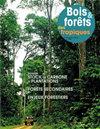A systematic review of antimalarial medicinal plants in Democratic Republic of the Congo
IF 0.6
4区 农林科学
Q3 FORESTRY
引用次数: 3
Abstract
In Democratic Republic of the Congo (DRC), malaria is caused by a parasite called Plasmodium falciparum. Malaria is one of the country's major public health issues and responsible for the death of tens of thousands of people every year in both rural and urban environments. Antimalarial drugs are commonly used but some recorded cases of drug resistance are a major obstacle to controlling the spread of malaria. It is therefore essential to identify new bioactive molecules as an alternative. Many medicinal plants with different properties have been used as treatments for a variety of diseases in the DRC, including malaria. This study provides a systematic review of antimalarial plant resources in the DRC. From 28 papers on ethnomedicine published between 2001 and 2019, a total of 232 plant species belonging to 67 different plant families and identified in 13 provinces was reported in the treatment of malaria. A large number of these plant species belong to the Fabaceae, Asteraceae, Euphorbiaceae, Rubiaceae, and Apocyanaceae families. Species cited in more than three provinces include Cymbopogon citratus, Vernonia amygdalina, Rauvolfia vomitoria and Catharanthus roseus. Most of the species identified as antimalarial plants were tree species, with phanerophytes predominating. In addition, leaves were identified as the main ingredients for preparing remedies, most commonly by decoction administered orally.刚果民主共和国抗疟药用植物系统综述
在刚果民主共和国,疟疾是由一种叫做恶性疟原虫的寄生虫引起的。疟疾是该国主要的公共卫生问题之一,每年在农村和城市环境中造成数万人死亡。通常使用抗疟药物,但一些记录在案的耐药性病例是控制疟疾传播的主要障碍。因此,有必要确定新的生物活性分子作为替代品。在刚果民主共和国,许多具有不同特性的药用植物已被用于治疗多种疾病,包括疟疾。本研究对刚果民主共和国的抗疟植物资源进行了系统综述。从2001年至2019年发表的28篇民族医学论文中,报告了在13个省发现的67个不同植物科的232种植物用于治疗疟疾。这些植物大部分属于豆科、菊科、大戟科、茜草科和夹竹桃科。在3个省以上被引用的物种包括Cymbopogon citratus、Vernonia amygdalina、Rauvolfia vomitoria和Catharanthus roseus。被鉴定为抗疟植物的树种多为乔木,以显生植物为主。此外,叶子被确定为制备补救措施的主要成分,最常用的是口服汤剂。
本文章由计算机程序翻译,如有差异,请以英文原文为准。
求助全文
约1分钟内获得全文
求助全文
来源期刊

Bois et Forets Des Tropiques
FORESTRY-
CiteScore
1.50
自引率
16.70%
发文量
31
审稿时长
>12 weeks
期刊介绍:
In 1947, the former Tropical Forest Technical Centre (CTFT), now part of CIRAD, created the journal Bois et Forêts des Tropiques. Since then, it has disseminated knowledge and research results on forests in intertropical and Mediterranean regions to more than sixty countries. The articles, peer evaluated and reviewed, are short, synthetic and accessible to researchers, engineers, technicians, students and decision-makers. They present original, innovative research results, inventions or discoveries. The journal publishes in an international dimension. The topics covered are of general interest and are aimed at an informed international audience.
 求助内容:
求助内容: 应助结果提醒方式:
应助结果提醒方式:


